Winning EDGE

A QUARTER-CENTURY OF DIVISION I SPORTS




A QUARTER-CENTURY OF DIVISION I SPORTS


3
Binghamton’s journey: How the University moved from Division III to the highest level of collegiate athletics. 8 11
Nick Billings: Basketball big man kicked off the D1 era with lots of blocked shots, slam dunks and West Gym fans.


Yun Qu: Chinese swimmer was an Olympian before becoming an All-American and setting pool records at Binghamton.
Kristie Bowers and Kristy Doerner: teammates remain leaders nearly 20 years after graduating.

Rory Quiller: to NCAA champion at the 2008 Division I indoor meet.
Scott Diamond: Starting pitcher became first Bearcat to play Major League Baseball when he joined the Minnesota Twins in 2011.


Welcome to the fourth edition of Winning Edge. In this issue, we celebrate 25 years as an NCAA Division I athletics program. We are commemorating this quarter-century mark with a closer look at some of the individual trailblazers and historic achievements that paved the way for our early success at the highest NCAA level. I hope you enjoy the trip back in time as we embrace our past and applaud those who steered us onto the path to become the successful, broad-based athletics program we are today.
The 2025–26 academic year is underway — and so is our quest to capture another America East Commissioner’s Cup as the top athletics program in the conference. After back-to-back titles in 2022–23 and 2023–24, we placed third last year but finished strong with three championships in the spring (men’s tennis, softball, baseball). Our student-athletes, coaches and staff are hard at work to meet the very high bar we now have established.
I would also like to formally welcome new Binghamton University President Anne D’Alleva, who comes to us from the University of Connecticut, where she served as executive vice president for academic affairs and provost. D'Alleva will be a great addition to our University community and the Southern Tier. Please join us in giving a Bearcat welcome to Anne D'Alleva!
Go Bearcats!
Sincerely,
Eugene Marshall Jr. Director of Athletics



Binghamton University embarked on its historic move from NCAA Division III to Division I intercollegiate athletics in the late 1990s.
In spring 1996, the campus Intercollegiate Athletics Board (IAB) voted to recommend to then-President Lois B. DeFleur that the University elevate to NCAA Division II and ultimately move toward NCAA Division I status. DeFleur agreed and the school began competing in NCAA Division II in the New England Collegiate Conference (NECC) in fall 1998. After serving three years at the Division II level, Binghamton moved to Division I and was accepted into the America East Conference in fall 2001. This fall marks the 25th year since Binghamton arrived at the NCAA’s highest level of athletics — and the quarter-century anniversary warrants a look back at the circumstances and successes that paved the way.
By John Hartrick

Before
Binghamton’s first NCAA Division I win. … Before the school gained membership into the America East Conference. … Before it ranked among the nation’s top 10% for overall Division III success in three successive years. … Before all of that — there was a battle over a fax machine.
In 1989, Director of Physical Education, Recreation and Athletics Joel Thirer took over an NCAA Division III athletics program that by all accounts was unremarkable. There had been pockets of team success over the years — particularly in wrestling and men’s soccer — and individual achievements across other sports. But unlike its closest neighbors and frequent opponents SUNY Cortland and Ithaca College, Binghamton didn’t possess a reputation or administrative support for athletics prowess. Those
“We were sorely lacking in staffing and resource allocation, and our facilities were fairly unacceptable.”
— Joel Thirer
two colleges boasted budgets more than triple Binghamton’s and while they set their sights on winning multiple NCAA titles yearly, Thirer’s goals were more rudimentary.
“We were sorely lacking in staffing and resource allocation, and our facilities were fairly unacceptable,” Thirer recalls. “We received a yearly appropriation from the Student Association (SA) toward operating expenses and I had to submit a budget to the assistant to the provost for his

Lois DeFleur, president of Binghamton University from 1991–2010, and Joel Thirer, director of athletics from 1989–2009, helped move Binghamton from the NCAA Division III level to Division I.
approval. In fall 1991, our newly hired sports information director requested a fax machine to send game results and stats to the Press & SunBulletin [newspaper]. That modest request was denied and met with the response: ‘Just use the fax machine in the Administration Building.’”
Ten years before winning a Division II President’s Cup that confirmed the school’s readiness to elevate to Division I, Binghamton still had to make strides just to become a respected Division III program, particularly in a region that, in addition

AUG. 31, 2001
Binghamton begins its Division I era when men’s soccer and women’s soccer compete in road tournaments. The women post the school’s first win at D1 with a 4-1 victory over Duquesne.
to Cortland and Ithaca, also included successful, well-funded, private-school athletic programs such as University of Rochester, Hamilton, Skidmore, Hobart and William Smith, and Rochester Institute of Technology.
The 1991 arrival of Lois B. DeFleur to start a 19year tenure as president changed the landscape of athletics at Binghamton. A former collegiate basketball player, DeFleur was supportive of athletics
“The decision to move to NCAA Division I is an investment in the future of Binghamton University.”
— President Lois DeFleur
and her vision for the University included a strong school spirit tied to a successful intercollegiate athletics program.
Thirer felt strongly that athletics should mirror the University in keeping company with academic peers, so DeFleur spoke with her colleagues at the other SUNY university centers at Buffalo, Albany and Stony Brook about their athletics programs. Buffalo had already begun its move toward Division I, and both Albany and Stony Brook were considering a similar move.
One salient point Thirer made in support of a divisional move was that Binghamton wasn’t competing against its academic peers while a member of the State University of New York Athletic Conference (SUNYAC). In fact, Binghamton was one of only 10 Division III public schools in the country with an enrollment of more than 10,000.

DEC. 16, 2001
Binghamton track and field greats Monique Hacker and Jewdyer Osborne, below, captured the University’s final Division III national championships in 1998.
The Division III level was composed of nearly 80% of private schools; 86% of the 350-plus membership had an enrollment below 5,000. Binghamton athletics didn’t fit the profile of an NCAA Division III program.
With DeFleur and Thirer leading the way, the University began a campaign to initiate a mandatory athletics fee. Despite early opposition, the fee passed and critical funding became available.
FAST FORWARD to 1996 and, with a stronger budget base, full-time coaches and a pointed focus on winning, Binghamton repeated as a top-15 program in the NCAA Directors’ Cup — a competition that rewards overall sports success based on NCAA tournament advancement. By March 1996, the school’s Intercollegiate Athletics Board (IAB) submitted a proposal to DeFleur to elevate the entire 19-sport athletics program to NCAA Division I. DeFleur approved the recommendation on March 26 and the wheels were set in motion.


Men’s basketball draws national attention and an ESPN highlight by taking ACC power North Carolina to the final buzzer in a 61-60 loss in Chapel Hill. Senior forward Jeffrey Daws hits a career-high six 3-pointers (19 points) and Binghamton had three potential game-winning shots in the closing 10 seconds.
In the school’s Division III finale on May 21–23, 1998, track and field standouts and future Hall of Famers Monique Hacker and Jewdyer Osborne won national championships in St. Paul, Minn. It was Hacker’s fifth NCAA title in three years. Osborne provided the school’s final Division III entry when he won the 110 hurdles championship with a dramatic lean at the tape.
By fall 1998 with athletics scholarships in hand, thanks to expanded fundraising and the athletics fee, Binghamton began competition in the New England

MARCH 6, 2002
Women’s basketball standout Sarah Cartmill becomes the first Binghamton athlete to be named America East Player of the Year.
Collegiate Conference alongside Albany and Stony Brook. One year later, Binghamton captured the NECC Presidents’ Cup as the top program in the 10team conference, giving the school all-sports titles in
Atop the “to-do” list for Thirer, DeFleur and Binghamton was to secure membership in a Division I conference ...
both Division III and Division II. The 1998–99 school year also ended with two big announcements — the first being that Binghamton would begin a twoyear NCAA Division I compliance period, setting the stage for Division I competition in fall of 2001. And the second was the unveiling of “Bearcats” as the school’s new nickname and logo, concluding a fouryear study and campus committee selection.
“The decision to move to NCAA Division I is an investment in the future of Binghamton University,” DeFleur said at the time. “I believe that

excellent academic programs as well as athletics are complementary learning experiences for many students, and competitive intercollegiate athletics enhance the quality of life on campus and in the local community. This move will raise Binghamton’s visibility and reputation.”


MARCH 9, 2002
Multi-sport athlete Andrew Verkey achieves the rare feat of competing at all three NCAA divisional levels. After three years of playing basketball at Binghamton as a Division III (1997–98) and Division II guard (1998–01), he plays lacrosse in the Bearcats’ inaugural Division I season in 2002 and is an America East all-conference defender.
Atop the “to-do” list for Thirer, DeFleur and Binghamton was to secure membership in a Division I conference — a critical step for longterm sustainability and success at the NCAA’s highest divisional level. While there were a few Northeast-based Division I conferences, the one with the best fit was the America East, which already was considering Albany and Stony Brook for membership. The fact that the America East had just lost core members Delaware, Hofstra, Towson and Drexel to the Colonial Athletic Association (CAA) opened the door for the three SUNY newcomers.
But Thirer and DeFleur still needed to persuade member schools that Binghamton was a viable candidate — one that would enhance the academic and athletic profile of the conference. What followed was an extensive campaign that included a barnstorming tour to the conference campuses and a comprehensive dossier touting Binghamton’s funding, sports offerings and recent success, facility

MARCH 23, 2002
Swimmer Yun Qu becomes the school’s first AllAmerican in any sport when she places 13th in the 200 butterfly at the NCAA Championships.
development, and support both on campus and with its alumni and fan base. To enhance the school’s bid for membership, Thirer offered to add men’s and women’s lacrosse as varsity sports. To say the school’s future as a viable Division I member hinged on the decision would not be hyperbole.
“We didn’t have a lot of other options,” Thirer recalls. “It was a pivotal point in time, just as our move into the Division II NECC was. We did a hard sell with the athletic directors and [DeFleur] worked hard lobbying the other presidents. The process was very stressful and it was never a done deal until it was over.”
Support from America East Commissioner Chris Monasch and ultimately a successful vote from the conference Presidents’ Council rewarded Binghamton with its first NCAA Division I “win” before any team took the field. On April 18, 2001, the conference and University jointly announced Binghamton’s membership effective July 1, 2001. Binghamton joined fellow new members Albany
Twenty-five years later, those seeds have yielded 57 conference championships, 35 NCAA Division I All-Americans and two recent Commissioner’s Cup titles as the top athletics program in the America East.
and Stony Brook, and existing members Boston University, Northeastern, Hartford, Maine, New Hampshire and Vermont.
“Not many schools have such an opportunity right out of the gate and we see it as a crowning moment for our program,” DeFleur said of the conference acceptance.
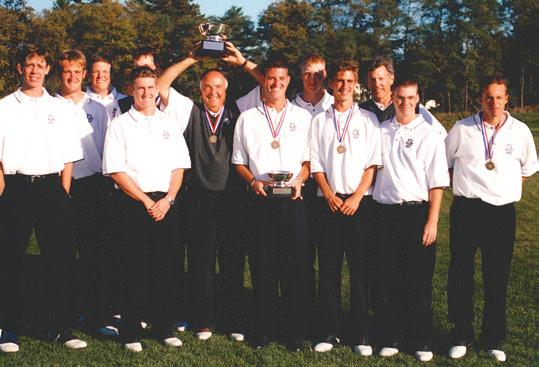

New York Gov. George Pataki, center, and state Sen. Thomas Libous, third from left, were among those who took part in the Events Center groundbreaking in June 2000.
“It’s an outstanding conference comprised of institutions that share our academic and athletics mission,” Thirer added. “It’s a perfect fit for Binghamton.”
With a stable Division I conference “home,” a $33.1 million Events Center fieldhouse under construction, a new nickname, and skyrocketing school spirit across the campus and region, the seeds were sewn. Twenty-five years later, those seeds have yielded 57 conference championships, 35 NCAA Division I All-Americans and two recent Commissioner’s Cup titles as the top athletics program in the America East.
“In retrospect, the battle to procure the necessary funding, overall resources, and dramatic facility upgrades became the driving force of my 20 years as athletics director,” says Thirer, who was inducted into the Binghamton Athletics Hall of Fame in 2011. “It was quite a journey.”
This issue takes its own journey through the last 25 years and highlights several other trailblazers and noteworthy achievements during the school’s formative years as an NCAA Division I program.
2002–03
The golf team wins seven tournaments – the most of any collegiate team in the nation at any level. The Bearcats win the America East and ECAC titles, produce a 161–40–4 record against the field (80%) and earn the program’s firstever NCAA Division I regional berth.

2002–03
Despite playing just 23 minutes a game, sophomore center Nick Billings compiles a school-record 117 blocked shots to rank second in the nation (4.3/game). He is named America East Defensive Player of the Year.


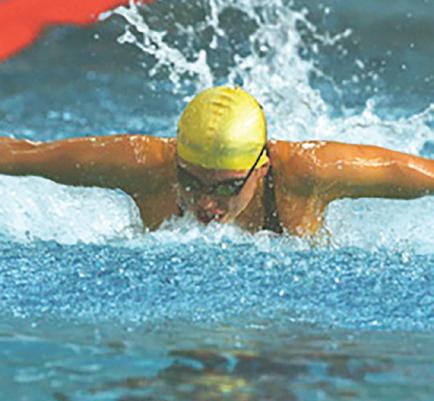


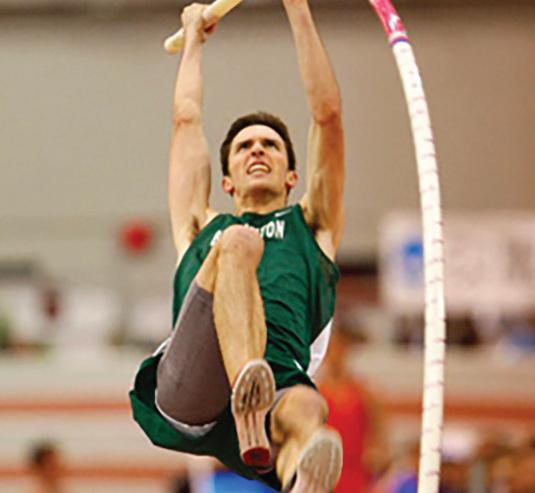
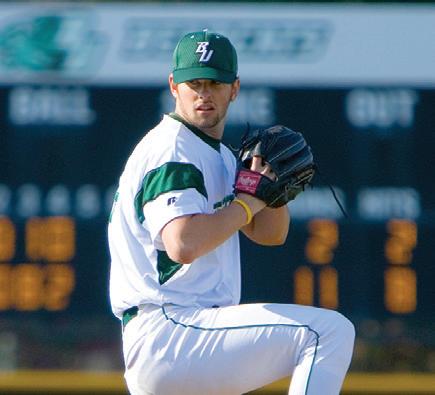
By John Hartrick
ERHAPS NO individual signified Binghamton’s emergence as a reputable Division I program more than 7-foot basketball star Nick Billings. Three months into the University’s inaugural Division I year, Billings took the court and what followed was a Hall of Fame career that both vaulted Billings into the nation’s top echelon of shot blockers and also created a palpable basketball buzz across campus and the community.
This was not your ordinary 7-footer, slow afoot and lacking the aerial athleticism and coordination of shorter players. Billings was a gifted athlete who could run the floor, flush alley-oops, dribble the basketball and, yes, block shots. Sometimes 10 a game.
The fact that he arrived to campus all the way from Kodiak Island, Alaska, only heightened his mystique. Kodiak is the nation’s second-largest island and requires a ferry or flight to get to

FEB. 16, 2003
Men’s swimming and diving becomes the school’s first team to capture an America East championship.


NOV. 15, 2003
Men’s soccer edges Northeastern, 3–2, in a shootout at West Gym Field to capture the program’s first America East title. One week later, the team defeats host and 13th-ranked FDU, 1–0, in the NCAA first round.
mainland Alaska. After leading his high school team to a 28–0 record and first state title as a senior, Billings packed his bags and traveled some 4,600 miles to a campus whose enrollment exceeded Kodiak’s population, brown bears and salmon aside.
“You don’t expect to find a 7-footer with good timing and instincts tucked away in Alaska,” recalls former Bearcat Assistant Coach Randy Dunton, himself a former Alaska state championship coach. “But once we saw some game film, it became clear Nick wasn’t just tall — he had real potential. He wasn’t just swatting at shots: he read the floor and anticipated.”

THE FIRST opponent to experience the Billingseffect was Dartmouth, Binghamton’s opening opponent in that 2001–02 season. In a 49–46 Bearcats victory — the program’s first as a Division I program — Billings played 15 minutes off the bench, hit three of four shots and blocked four on the defensive end. One month later at the Dean Smith Center in Chapel Hill, his uncanny athleticism was on display when the Bearcats pushed heavily-favored North Carolina to the wire in a 61–60 loss. Late in the first half, Billings cut into the defensive passing lane on the wing, dribbled some 70 feet ahead of two chasing Tar Heel guards and, five dribbles later, flushed it down to complete the steal and score.
Before his freshman season was cut short with an injury after 21 games, Billings registered 12 more games with four-plus blocks, including a nine-block game against Colgate. Even missing the final eight games of the season, he set the new standard with 80 blocks and his 3.8 average ranked sixth in the NCAA. Limited to under 18 minutes a game, Billings’ prorated full-game averages were in lofty tripledouble range: 12.0 points, 11.3 rebounds and 8.7 blocks.

JAN. 31, 2004
Just as eye-opening was his campus effect. At a school where even the most accomplished studentathletes go relatively unnoticed, Billings drew attention. He was a rock star. A man of the people, if you will. The West Gym was packed for “Midnight Madness” those years and the student fans kept coming during the season. The “Kodiak Kid” signs came out. Membership in the Junior Bearcat Club skyrocketed. Who wouldn’t want to see a 7-footer swat shots into the stands, elevate and throw down a perfectly timed alley-oop from all-conference point guard Anthony Green, and then high-five fans, sign autographs postgame, and do it all with a flair?
“I’m usually a pretty friendly and outgoing person in general and always tried to give the crowd a show when we played and a lot of the fans enjoyed that,” Billings says. “I was an animated player who showed my passion. But I also watched and cheered on the other [Binghamton] athletes at their home games and became friends with everyone.”
“Nick had this rare mix: He was this imposing figure on the court, but off the court he was just a big, approachable, funny guy,” Dunton says. “He made people feel comfortable.”
Men’s basketball hosts Hartford in the first game played at the Events Center. Binghamton posts a 75–68 victory in front of a standing-room-only crowd of 4,660.

MAY 1, 2004
In just its third season as a varsity sport, men’s lacrosse wins the America East regular season title with a 9–8 victory at UAlbany.


THE BEARCATS and Billings got comfortable in 2002–03. The team won 14 games, including nine in the America East, and went 10-2 at home. After finishing sixth (out of nine) in its first Division I conference season, Binghamton moved into the top half of the league during Billings’ sophomore year. Despite still playing barely half the game, he jumped his scoring average up to 9.0 points and his 4.3 blocks per game ranked No. 2 in the nation, behind only UConn star Emeka Okafor. Billings was named America East Defensive Player of the Year and repeated as all-conference. His 117 blocks were the third-highest total in America East history and included two school-record 10-block performances vs. conference foes Boston University and Northeastern.
The block numbers were staggering not only in their sheer volume, but also in the realization that for as many shots as he rejected, he altered

Men’s tennis defeats archrival Stony Brook, 4–3, for the third straight year in the America East championship match, returning to NCAAs.
or discouraged dozens more per game. Opposing guards and forwards alike had to reconsider their intentions of driving to the hoop, where Billings loomed. Offenses had to adjust. It just wasn’t a viable offensive strategy to attack the rim.
Modern analytics now chart individual block percentages. Former 7-foot-6 NBA player Shaun Bradley holds the highest NBA career blocks percentage at 7.8%. Billings’ percentage as a freshman was 22.9%, meaning he blocked nearly a quarter of all two-point shots. No college player in the last 15 years has come close to that figure.
Just how much joy did a block or two or three bring to Billings?
“Other than dunking on someone, blocking shots is the greatest feeling,” he says. “I loved that my teammates knew if their man beat them or someone had a better position on them in the paint, there’d be a real good chance I’d be there to help. Protecting my teammates always brought me pride and joy.”
When the Bearcats christened the Events Center in the second half of the 2003–04 season, attendance swelled. Fans wanted to not only see the $33.1 million facility, but also see their favorite player. NBA scouts were regular attendees at home and on the road.
Billings finished his career with a school-record
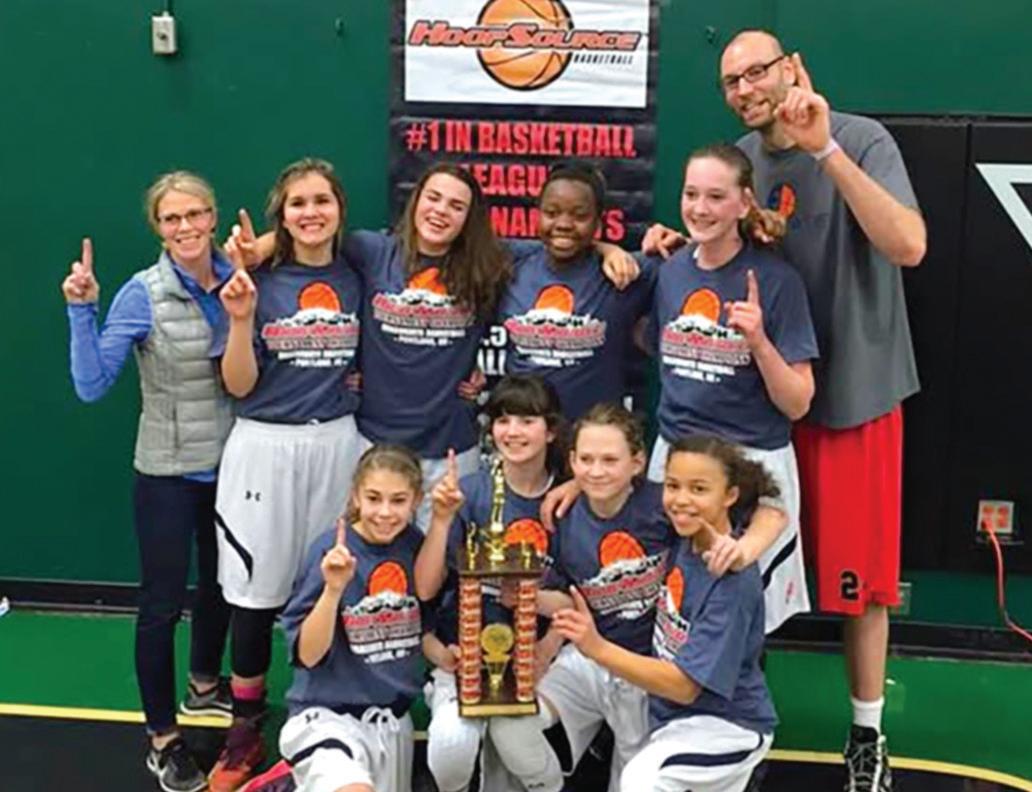

336 blocks — still the second-highest total in the 46-year history of the America East. Beginning with several stints in the NBA Developmental League, Billings’ eight-year professional career took him to Argentina, Denmark, Japan, Norway and Uruguay.
When his knees finally gave out, Billings returned to Alaska, where he was a counselor at several group homes. He then earned his master’s degree in secondary education and began teaching and coaching. True to his human development major at Binghamton, Billings remains rooted in
relationships. Billings has taught middle school history for the last six years. This heartfelt bond with young people and a drive to help them blossom comes as no surprise to Dunton.
“Nick never carried himself like he was bigger than the program or anyone else,” Dunton says. “He leaned into campus life and was always smiling and saying yes to things. The community youth loved Nick. That goes a long way. People remember that.”
And more than 20 years later, people still vividly remember the “Kodiak Kid.”
Olympic swimmer Yun Qu made an unlikely journey from China to Binghamton.
By John Hartrick
YUN QU began swimming at age 7, when a coach spotted her potential even before she swam any laps. She left home for boarding school at 12, and, during her formative years, her fun and friends were intertwined with her swim teammates.
By age 15, she was the world’s No. 1 ranked 200-meter butterflier. Qu was beginning an eightyear international swim career that yielded multiple world championship medals and 10 Chinese national titles. At the peak of her career, Yun represented China at the 1996 Olympic Games in Atlanta and placed fourth in an elite field of 35 of the world’s fastest swimmers (top U.S. swimmer Trina Jackson placed seventh).
Some 12,000 kilometers from her hometown of Hangzhou, Binghamton University was beginning its divisional transition. By 1998, Binghamton hired head coach Benji DeMotte to guide the move. Despite steering his women’s team to three consecutive Division II championships in the swim-specific Metro Conference, DeMotte knew he needed more

MARCH 14, 2008
Pole vaulter Rory Quiller becomes Binghamton’s first NCAA champion when he clears 18-feet-1/2 inch to win the NCAA Indoor title at University of Arkansas.

firepower to compete at the highest NCAA level.
“We really needed to make an instant jump in our recruiting, so I chased down every rabbit hole I could,” he says.
Meanwhile, Qu continued competing after her Olympics debut and added two more gold medals at the 1997 Chinese Championships. In her final international competition, she placed fifth at the 1998 World Aquatics Championship.

MARCH 14, 2009
Before a sold-out Events Center crowd of 5,342 and a national TV audience on ESPN2, men’s basketball topples UMBC, 61–51, to capture its first conference title in 63 years of sport sponsorship. Five days later, Binghamton faces No. 2 seed Duke in the first round of the NCAA Tournament in Greensboro, N.C., in a game televised on CBS. The Bearcats fall, 86–62, despite 20 points from D.J. Rivera.
By 2000, she was enrolled in Shenzhen University, but was advised to explore educational opportunities abroad. A recruiting service sent faxes to more than 100 college swim coaches — and DeMotte’s eyes lit up when he saw her times and accomplishments. Qu initially declined a phone call with DeMotte due to her nervousness speaking English.
What followed was a year-long recruiting relationship that blossomed through a then-new platform called AOL Instant Messenger (AIM).
“I knew recruiting someone of Yun’s caliber would make a huge, huge impact for us,” he recalls. “And I also knew that most international athletes choose an American school based primarily on the relationship they form with the coach, compared to U.S. kids who put more weight on the school’s name recognition.”
While SEC member Arkansas, with its six Olympians and 46 AllAmericans, also was recruiting Qu, DeMotte had a fighting chance.
For almost a year, DeMotte and Qu chatted daily on IM.
“Yun used it to learn English and I used it to learn how to type,” DeMotte quips.

“Benji went above and beyond,” Qu says. “He helped me navigate every step of the recruiting process. … Without his support — and patience — I don’t think I would’ve made it to Binghamton.”
QU ARRIVED on campus in January 2002 and met DeMotte for a one-on-one workout in the West Gym Pool.
“Of course, I had to write a 200 fly into that practice just to see what she could do,” he says.

MARCH 19–21, 2009
Junior 184-pound wrestler Josh Patterson wins five matches to place seventh at the NCAA Championship in St. Louis to become the program’s first Division I All-American. Patterson leads the nation in wins (46) and pins (22) in 2008–09.

“And her first 200 fly in our pool did two things: One, it was a time that would be fast enough to qualify for the NCAA Division I Championships. And two, it would beat Gina Bonante’s school record by nine seconds. Gina was a Division II All-American for us, so I knew we had someone special.”
Special is also how Qu described her relationships with DeMotte and her teammates.
“I loved the team bonding outside the pool just as much as the training itself,” she says.
What followed were pool and school records, conference crowns and NCAA Championship appearances in each of Qu’s three years at Binghamton. She put Binghamton on the NCAA swim map with her first championship in February 2002 at the University of Texas. Qu placed 13th at the meet, becoming the school’s first Division I AllAmerican and providing DeMotte and Binghamton

MAY 30, 2009
One week after winning its first America East tournament title, baseball records its first-ever NCAA postseason win with an 11–6 victory over No. 30 George Mason at the East Carolina Regional.
“instant name recognition” that paid off in future recruiting.
“There’s no way to quantify her impact on our program,” Demotte says. “She brought us up into a new level of success and exposure. And her leadership, work ethic and talent all served to inspire her teammates and recruits.”
Qu capped her first semester as both America East Swimmer of the Year and Binghamton Athlete of the Year. When she finished her career and graduated summa cum laude in 2005, she left the pool as a sixtime America East champion and holder of seven Binghamton records.
Qu did her own recruiting, too, bringing over former Chinese teammate Huijue Cai in 2003. Like Qu, Cai won six conference titles and the pair represented Binghamton at the 2003 NCAA Championships at Auburn University.
“I told Huijue how much the experience at Binghamton had opened my world,” Qu says of the recruiting assist. “Between the training, education and life lessons, I felt like it was too good not to share.”
ALONG WITH her swim accolades, Qu was named America East Scholar-Athlete of the Year in 2004 and was selected as Binghamton’s John Bilos Award winner for career achievement.
Qu went on to receive her master’s degree in sports psychology from Ithaca College in 2006 and coached at Iowa State for two years before returning to Binghamton to serve as an assistant coach for four years. During that time, she was part of a staff that was named America East Coaching Staff of the Year in 2011.
DeMotte knew she would make an exceptional coach.
“Yun has incredible empathy for athletes but she also has traveled a much more grueling path, which gives her instant credibility with athletes. She is an incredibly sweet person … and unlike many elite
athletes, she carries no ego. I can’t remember a time Yun was ever in a bad mood. Happy coaches tend to create happy swimmers.”
Since leaving campus in 2012, Qu has been in Atlanta, where she works as an assistant coach at Georgia Tech and runs a youth swim program. Qu also returns to China every summer to support developing swimmers. It’s fitting that she found her way back to the very city and pool (Georgia Tech Aquatics Center) where she had her first introduction to the United States at the 1996 Olympics.
But even in Atlanta, Binghamton and DeMotte were never far from her mind. In 2018, Yun and her husband Danny Wang welcomed their second child — a boy to join their 4-yearold daughter, Lilly. DeMotte emotionally recalls a text he received from Yun while coaching a Virginia club team at a meet in Orlando.

“I was surrounded by my high school swimmers and the text had a photo of her newborn son with the caption: ‘Welcome Benji to our family,’” he says. “That day of coaching was one of the most impactful in my entire career and didn’t have anything to do with what was happening on the pool deck.”
In naming her son after DeMotte, Qu provided a strong example of the role coaches play in the lives of their student-athletes.
“Coach Benji made a huge impact on my life,” she says. “Naming my son after him felt like a small way to honor that.”
In the annals of Binghamton athletics, Qu herself will forever be honored.

JAN. 31, 2010
Erik van Ingen becomes the first Binghamton athlete to break the fourminute mile barrier when he wins the Penn State National Open in 3:59.58. The time earns him a spot in the NCAA Indoor Track & Field Championship in March, where he places 11th.

MARCH 18–20, 2010
Wrestler Justin Lister storms through the NCAA Championship bracket enroute to a fourth-place finish at Nebraska-Omaha. Unseeded at 157, Lister becomes the first Binghamton wrestler to reach the semifinals and pins two of the top-four seeds in dramatic fashion.
Goalkeepers
Kristy Doerner, wearing No. O at right, and Kristie Bowers, far right, led the women’s soccer team for four seasons at Binghamton University.
Pair anchored women’s soccer defense before forging elite careers off the field.
By John Hartrick
KRISTIE BOWERS oversees a staff of 125plus and a budget in excess of $11 million. Kristy Doerner has protected presidents and vice presidents across the world and her forensic work has brought murderers to justice.
But back in 2003, they came to campus as acclaimed high school goalkeepers. Head coach Jeff Leightman brought them as part of his Division I program buildup — one that quickly appeared poised for championship-level play.
While they shared the same first name and position on the field, they were different. Bowers


JUNE 10, 2010
hailed from upstate New York (Rochester), was two inches shorter, vocal, intense and full of confidence. Doerner was from downstate (Shoreham), was quiet and unassuming, but carried herself with a presence.
In four years, the pair shared goalkeeper duties, a dorm room, a conference title and leadership qualities that not only inspired their teammates, but forecast future career success.

BOWERS WAS a captain and allstate keeper at Greece Olympia High School, where she set the school record for saves in a season and was the school’s Athlete of the Year as a senior.
As is often the case, her sport and position owe their roots to family — her older soccer-playing sister needed someone to shoot against. A love was

Men’s tennis earns a final national ranking of 49th after an historic 25–2 season that includes an America East title and No. 2 ranking in the ITA Northeast Region.

Tennis All-American Sven Vloedgraven wins his second straight ITA Northeast Region singles titles and is the No. 1 ranked player in the region.


born. The position requires vocal leadership, quick problem-solving and a big-moment mentality.
“Thinking ahead of plays and solving problems the opponent puts your teammates in was fun for me,” Bowers says.
Meanwhile, on the north shore of Long Island, Doerner was closing a high school soccer career that included three all-conference honors, team captain and MVP status. Like Bowers, Doerner was introduced to the game by an older sister. While Doerner split time between field positions and goalie early on, she was drawn to that final line of defense.
“It’s a very cerebral position,” Doerner says. “I like reading the game, organizing my defense and being able to make a save if all else fails. I enjoy being the person who can hold the entire team up on their shoulders by making a save.”
In fall 2003, Binghamton soccer teammates were treated to two gifted and hard-working freshmen keepers who put team first. What resulted was a nine-win season in 2003 and then a 14-win campaign in 2004 that yielded the program’s first America East championship and NCAA Division I Tournament berth. Another double-digit win season in 2005 cemented a four-year span with an average of 10 wins per season — a lofty soccer standard.
Bowers started 74 career games and graduated as the school’s all-time leader in saves (383) and

shutouts (29). In the 2004 championship season, she notched seven shutouts and then blanked Northeastern and Maine to capture the historic conference title. As a junior, Bowers was named all-conference after she led the America East with nine shutouts, ranked fifth in the nation in save percentage, and posted a paltry 0.73 goals against average.
That sophomore year was memorable for Doerner in other ways, too. She began a heavy course load in chemistry, her chosen major from high school, and had to learn time management to excel at Division I soccer and in Binghamton’s rigorous academic setting.
“That year definitely made me the person I am today,” she says, “especially how I look at and adjust to situations, and knowing how far I can push myself.”
As a senior in 2006, Doerner was named a team captain — a nod to her selfless leadership and influence on the team.
WITH AN early eye on teaching and coaching, Bowers finished her human development major halfway through her four years. She enhanced her college experience by working in the athletics equipment room and as an events staff member. Between these roles and her work with the Student-
JULY 18, 2011 Scott Diamond becomes the first Binghamton baseball player to reach the major leagues when he makes his debut for the Minnesota Twins. In front of 40,000 fans at Target Field against Cleveland, Diamond pitches 6.1 innings.

Kristie Bowers and Kristy Doerner sit front and center for the 2006 women’s soccer team picture. The goalkeepers helped the Bearcats win the America East championship and go to the NCAA Tournament in 2004.
MARCH 17, 2012
Wrestling crowns two All-Americans and places 14th at the NCAA Championship — the highest finish in program history. Donnie Vinson wins a tournament-high seven consecutive matches to place a program-best third at 149.
Athlete Advisory Committee (SAAC), Bowers was one of the most recognizable student-athletes around athletics venues. She was exposed to athletics facilities and game-day management personnel and saw the inner workings of an athletics department. Those experiences piqued her interest in a possible career in college athletics.
She played professionally in the United Soccer League for three summers before graduating and heading to Western Carolina for graduate school and a graduate assistant coaching position.
In 2011, Bowers returned to Binghamton as assistant women’s soccer coach, but also had a goal of earning her doctorate.
“I wanted to contribute to the field that could advocate for why athletics belonged as a cocurricular experience in higher education,” she says.
While coaching and soccer were formative in her life, Bowers believed she could more


positively influence student-athletes as a leader of coaches and staff. What followed was a shift into athletics administration at Binghamton and key contributions in academic advising and support services. By 2017, Bowers was the assistant athletic director for student-athlete support and development. That led to a four-year administrative role at Boston University, where she became senior associate athletic director and senior woman administrator.
In August 2023, Bowers was named associate vice president and director of athletics at Rensselaer Polytechnic Institute in Troy, N.Y. She is the first female AD in school history.
Now in her third year leading the Engineers, Bowers is steadfast in her vision.
“I tell our staff our mission remains the same: to guide student-athletes to become adults confident in their preparation, academically and personally, so they are ready to change the world. Each person and team is different on their journey toward success. But that moment they achieve something they didn’t think they could is pretty special.”

JUNE 5, 2012
influences from two uncles who were police detectives, Doerner’s career interests began in high school when she took a strong liking to chemistry. She wanted to work in forensics and knew that path began with a science degree followed by graduate work. After graduating from Binghamton in 2007, Doerner earned her master’s degree in forensic science with a concentration in crime-scene investigation from George Washington University — one of

12, 2015
at the NCAA Outdoor Track & Field Championships to earn first-team All-America honors.
the nation’s most prestigious forensic science programs.
From there, she landed a job with the United States Secret Service as an officer in the crime-scene search unit. For eight years, Doerner was assigned to Washington, D.C., and, among other duties, provided protection for the White House and Vice President’s Residence.
She served political campaigns, presidential inaugurations, United Nation visits, national security visits and presidential visits across the globe. Doerner secured locations in countries such as Ethiopia, Tanzania, Saudi Arabia, Japan, Ireland and Poland.


Firearms and Explosives. It was her desire to carry an investigation through from start to finish that led to the shift. Doerner also was drawn to ATF for its mission of reducing violent crime.
In 2013, Doerner was back at Binghamton University, serving on the equipment team that screened visitors when President Obama spoke in the Mandela Room in the University Union. It was a full-circle moment for Doerner: 10 years earlier she was defending her soccer net, but now was casting her own net to protect the president.
With the Secret Service, Doerner also was a crimescene technician, with responsibilities for collecting and analyzing evidence for crimes that occurred at diplomatic locations and embassies in D.C.
“My chemistry background definitely helped me understand why certain tests or collection techniques work for different situations,” she says.
Doerner left the Secret Service in 2017 to become a special agent with the Bureau of Alcohol, Tobacco,
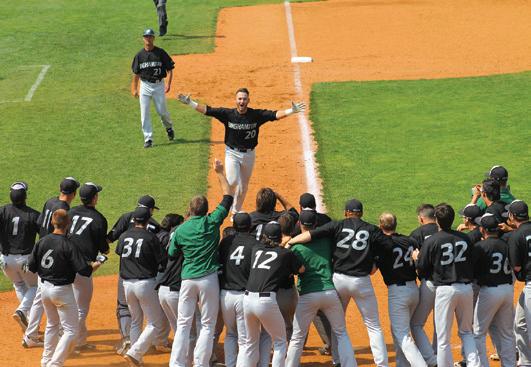
MAY 27, 2016
“We investigate the most violent offenders so that we can make communities safer,” she says.
She also likes the agency’s ties to local law enforcement so cases can come to a conclusion.
As for the daily personal danger she encounters, Doerner stresses the abundance of training and precautions.
“How we train and prepare helps mitigate the danger,” she says. “We all work together so I know what each member of my team is capable of and we work so that everyone goes home safe at the end of the day.”
Some 20 years ago, Bowers and Doerner were midway through their undergraduate careers as student-athletes. Two goalkeepers … trained to stop threats, solve problems and lead their teams. Some things never change.
Catcher Jason Agresti hits a walk-off grand slam to complete a stunning nine-run ninth inning that rallies baseball past Hartford, 9–6, in the America East semifinals. One day later, Binghamton defeats Stony Brook, 6–3, to capture the program’s third conference title in four years.

spent eight years with the U.S. Secret Service before joining the Bureau of Alcohol, Tobacco, Firearms and Explosives (ATF) in 2017.
MARCH 3–5, 2017
Baseball completes a four-game series sweep of No. 19 Virginia Tech on the road. It’s the first time the ACC-member Hokies have ever lost a four-game series at home. Binghamton finishes the regular season with a 30–11 record and RPI of 58 out of 299.
Rory Quiller won University’s
By David O’Brian
ARCH 14, 2008: It is probably the most significant date during Binghamton University’s quarter-century in NCAA Division I athletics. It was on that date that Rory Quiller won the national championship in the men’s pole vault at the NCAA Division I Indoor Track & Field Championships. Seventeen years later, it remains the only national title won by the Bearcats at the Division I level.
Quiller’s journey to the 2008 indoor meet transcended the Binghamton University Athletics Department. It was one of the biggest stories on campus and in the community at the time — even more so than the America East Men’s Basketball Tournament being held at the Events Center that same month. Quiller had been the runner-up at the 2007 NCAA indoor meet and was ranked first in the nation in his event. But while the expectations were sky-high, Quiller and coach Mike Thompson kept a perspective about the upcoming meet.
says. “And overall, we were keeping things as low-key as possible, despite the media attention that he was receiving. Whenever anyone asked Rory what the goal was, he would say ‘do better than last year.’ Of course, he finished second the year before, so it was obvious what that meant. But we never mentioned winning being the goal.”
No matter how low-key Thompson and Quiller tried to keep things, the pressure of winning was clearly evident during the final stages at the 2008 NCAA meet. Quiller was down to his last attempt at 18 feet. If he made it, he was in the driver’s seat to take home the title. If he missed it, he would have settled for fifth place.

“It was very stressful,” Thompson says. “Easily the most stressful moment in my career as a coach or an athlete. Make it and probably win, miss it and finish fifth. When he cleared on his third attempt it was exciting and a big relief, but a couple of other athletes still had one attempt left, so I quickly calmed down and prepared for the next height.”
“The year before, going into the (2007) indoor meet, I was probably ranked outside the top 10 and got second,” Quiller says. “I knew first-hand that the pole vault event can be very volatile. So, no matter the rankings going in, the top 16 guys in the country were there, and all of them had the ability to win it.”
“Training-wise, nothing changed from the normal routine leading up to the national meet,” Thompson
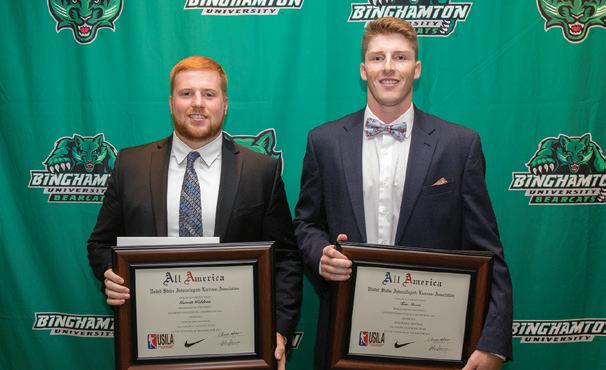
MAY 24, 2017
Quiller did clear the bar on that crucial attempt and then waited out the final competitors also trying to clear that height.
“I knew when I made the third attempt at [18 feet], I was in the lead, but I can remember I fully expected a few guys to make that height and the competition would continue,” he says. “Even when the final remaining competitor missed his third attempt, there was a protest and discussion among

MARCH 14, 2018
Women’s basketball wins a national tournament game with its 70–59 victory over Youngstown State in the WBI. It gives the team a 20win season — its most wins in 17 years.

Rory Quiller is the only Binghamton University student-athlete to win an NCAA Division I national championship.
Quiller won the pole vault in 2008.

AUG. 27, 2018
Murphy Smith makes his MLB debut with the Toronto Blue Jays after pitching 10 years in the minor leagues. Smith enters in the seventh inning at Baltimore and retires all four batters he faces. He becomes the oldest player (31) in Toronto history to make his MLB debut and becomes the second Bearcat baseball player to reach the pinnacle of professional baseball.
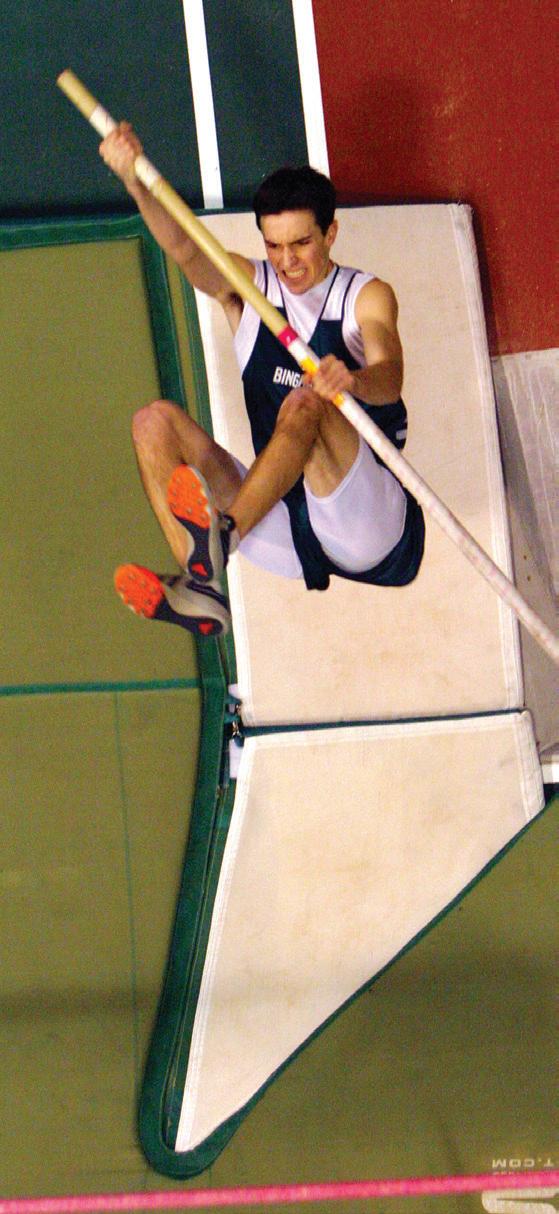
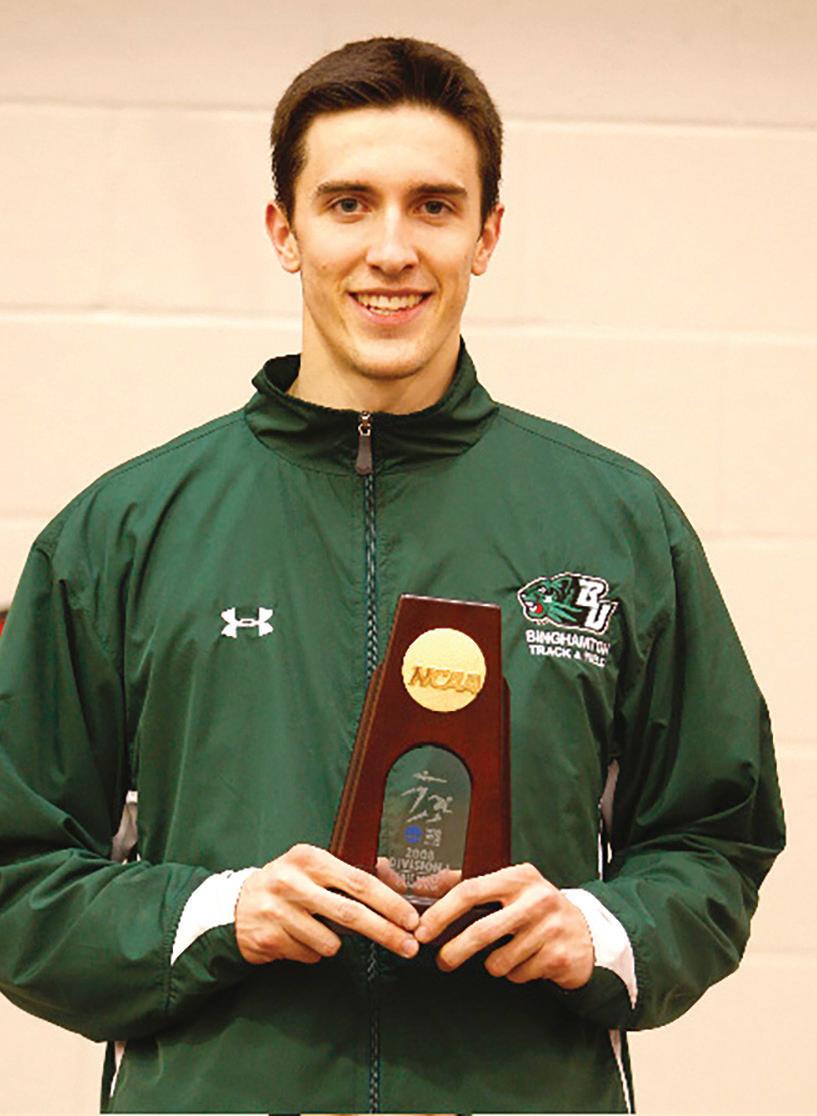

MAY 23–25, 2019
Shane Marshall sets an America East baseball record by homering in four consecutive postseason tournament games at the America East Tournament, hosted by Binghamton.
Rory Quiller received his coaching from Mike Thompson, who won Division II indoor and outdoor pole vault championships in 1989. Thompson is still head track and field coach at Binghamton University.

the officials. I just focused on what I could control.”
Quiller ended up winning the title. Quiller, Thompson and family then went out to dinner afterwards. It was a full circle moment for Thompson, who had won the 1989 NCAA Division II indoor and outdoor pole vault titles during his collegiate career at Northern Colorado. That became one of the dinner conversations among the group.
“I think the win probably set in emotionally when Coach and my family all went out to dinner, and Coach Thompson shook my hand and said good job. I believe his quote was: ‘Winning one national championship is pretty good.’ But I knew he had won two.”
While the dinner was low-key, the reception Quiller and Thompson got back on campus was not. Both were honored by the campus and community for their accomplishments at a welcome-home event. Local media was on hand and several proclamations were read.
The truest impact of Quiller’s win, however, was

The men’s swimming & diving team produces a perfect 5-0 dual meet season and then captures the program’s first America East title in 18 years by edging 12time champion UMBC.
felt at the Binghamton Athletics Department’s Annual Awards Banquet two months later. When Quiller was announced as the Male Athlete of the Year, he received a standing ovation that went on for more than a minute. He was asked to come to the stage and say a few words, which no one had planned beforehand.
“I remember feeling very awkward because I had nothing prepared and was standing at a podium in front of every athlete and the entire athletics staff at Binghamton,” Quiller says. “I don’t remember anything about what I said, but I remember wanting to express gratitude for all the support and wanting to convey what my father always said — that being a good athlete is a far second to being a good person. So, hopefully, that came across.”
These days, Quiller is married with a family and is coaching the pole vault at the U.S. Naval Academy. It has been nearly two decades since his historic victory and he is able to look back on the event with a different perspective.
“All this time later, I think the luster of that win has faded into a random trivia fact, and what has replaced it is so much more meaningful,” he says. “As I became a father and a coach, I look back at that moment through those lenses and I’m so happy that I could share the experience and accomplishment with my parents and my coach. They poured so much into my development and cared for me more than I deserved. Hopefully, they feel like they did a good job.”
Thompson, meanwhile, is still the head coach at Binghamton University. To him, Quiller’s win is anything but a trivia fact.
“It remains the single most impressive performance in Binghamton track and field history,” he says. “Not just because it was a national title, but also because of the way Rory handled the pressure he was under the entire season, and especially the way he handled the pressure of needing to make his final attempt to win. It was a fantastic performance.”

With COVID condensing the sports seasons, distance runner Emily Mackay produces two record-setting All-America performances in a four-month span. Mackay becomes Binghamton’s first Division I female cross country All-American when she places 14th at the NCAA Championship. She then places seventh in the 5,000 meters at the NCAA Outdoor Track & Field Championships.
Pitcher Scott Diamond was first Bearcat to play in MLB.
By Eric Coker
SCOTT DIAMOND faced a life-changing decision in mid-August 2007.
Stay at Binghamton University for a senior year and continue to lead and pitch for the reigning America East regular-season champions.
Or … sign a free-agent contract with the Atlanta Braves and start a professional baseball career.
“I talked with a lot of mentors, coaches and professors about the opportunity,” Diamond recalls.
“It’s hard to tell friends that you’re going in a new direction, but I could always return to academics. I knew it was a short window to pursue baseball — and I had to make the leap.”
That decision — made a mere five days before the 2007–08 academic year began — took on even greater significance on July 18, 2011, when Diamond became the first Binghamton student-athlete to play Major League Baseball. More than 14 years later, Diamond remains one of two Bearcats (along with pitcher Murphy Smith) to reach the peak of pro baseball.
“Being the first [MLB player] is an absolute honor,” Diamond says. “But if it wasn’t going to be me, it was going to be one of the other guys given the program mindset and knowing that we can be the best.”
DIAMOND GREW up in Guelph, Ontario, a city about 45 minutes southwest of Toronto. He idolized pitchers such as Andy Pettitte, Roger Clemens and Mel Melehes, a Guelph native who pitched for Greece in the 2004 Olympics. In May 2025, Diamond was inducted into the Guelph Sports Hall of Fame (fitting, as he was Guelph’s first major leaguer since 1883).
The lefthanded pitcher was pursued by several

MARCH 6, 2022


Division I schools, but was drawn to Binghamton’s strong academics and its move to the NCAA’s highest level in 2001.
“The team size at the time was about 26 players, compared to 36 or 40 at other schools,” Diamond says. “You have four years — and I’m not the kind of guy who wants to sit around. I wanted to play from the very beginning. Combined with the academics, Binghamton was the clear standout for me.”
Despite a rocky collegiate debut that saw him walk eight consecutive Oklahoma State hitters, Diamond had a strong freshman season in 2005: He was the America East Rookie of the Year with a 4–6 record, 4.15 ERA and four complete games. Diamond credits the early success to the push and support he received from older pitchers such as Tom Gaube, Adam Shatkun and David Lind.
“That season allowed me to see that I had a chance to take the next steps,” he says.
As a sophomore, Diamond won five games and led the Bearcats in starts and innings pitched. He also started to get the attention of baseball scouts while
Lou DePrez wins his third consecutive EIWA Wrestling Championship and advances to the NCAA Championships for the fourth straight year.

SPRING 2022
In the same season it opens its $60 million home complex, the baseball team wins its fifth America East title and competes at the NCAA Stanford Regional.
Scott Diamond entered the Binghamton University Athletics Hall of Fame in 2013, two years after making his Major League Baseball debut with the Minnesota Twins.
playing for the Martinsville Mustangs in the Coastal Plain League in the summer of 2006.
Binghamton baseball catapulted to the top of the America East in 2007— and Diamond played a key role. He was a part of a dominant pitching staff that featured fellow starters Zach Groh, Mike Van Gorder and Jeff Dennis (a 2008 Oakland A’s draft pick) and relievers Smith (who would pitch for the Toronto Blue Jays in 2018), Greg Lane and Khalid Afify.
Diamond went 5–3 with a 3.45 ERA for a Bearcat team that won the America East regular-season title with a 17–5 record.




Emily Mackay concludes her historic cross country and track career with three All-America honors, highlighted by a sixth-place finish in the women’s 1,500 at the NCAA Outdoor Track Championships. Mackay also achieves the rare feat of qualifying for all three NCAA track and cross country meets during the year.
“That team just gelled incredibly well, on and off the field,” Diamond says of the squad led by head coach Tim Sinicki. “We were proud of what we accomplished in the America East. It was unheard of: Two years before, we were fighting for a playoff spot and now we were cruising into the No. 1 seed.”
The dream season ended with a loss to UAlbany in the America East championship.
“I remember the highs of the season and the heartbreak, too,” Diamond says. “The hardest part was knowing there was a chance I wouldn’t be back and guys like Van Gorder, Matt Simek, Justin Smucker and Pat Haughie were in their last season. But I’m happy that, within two years, they made [the NCAAs] and won a game. The program has only grown since.”
DIAMOND FACED more disappointment in the summer of 2007 when he was not selected in the MLB Draft. But he returned to Martinsville and pitched so well that the Braves made him a latesummer free-agent offer. In 2008, Diamond skipped rookie-ball level and started at Low-A Rome, before quickly moving to High-A Myrtle Beach. It was a spectacular debut pro season: a combined 15–3 record with a 2.89 ERA over 24 starts.
“I was grateful for the opportunity,” he says. “I wasn’t drafted. And I was the fourth-best pitcher on our Binghamton team. So, I was able to play with such an ease that everything clicked.”
Diamond advanced to AAA before being selected by the Minnesota Twins in the 2010 Rule 5 Draft, which allows teams to pick other organizations’ minor leaguers who are not “protected” on the 40man roster.
He made his MLB debut on July 18, 2011, against the Cleveland Indians, starting the second game of a doubleheader. The doubleheader aspect of the day remains memorable for Diamond.
“The first game was at noon and the second was at 7,” he says. “I flew in the night before and looked at ESPN to see who the ‘probable starters’ were. It said I

Reserve goalkeeper Nicole Scott stops three of four penalty kicks to lift women’s soccer to a semifinal shootout win over UAlbany and advance Binghamton into the conference championship for the second time in three years.
was starting the first game. So, I got to the stadium at 8 a.m. before any coaches or players. I was sitting at the locker when the coaches came in and said: ‘What are you doing here? You’re not starting until the night game.’ I was lost for words! They told me to go back to the hotel, but I said I wanted to hang around and calm my nerves.”
Diamond pitched 6.1 innings and allowed three runs. He recalls the advice he received from thenTwins’ first baseman Justin Morneau: Get the ball, take it all in, enjoy it, and remember what you are there for.
“That’s exactly what I tried to do,” Diamond says. “I’m proud of my debut and being able to share that experience with a lot of different people.”
Diamond, who earned his bachelor’s degree in industrial and systems engineering from Binghamton in 2011, had his best season for the Twins in 2012, going 12–9 with a 3.54 ERA in 27 starts (including a shutout over Cleveland). He was named Twins’ Pitcher of the Year in 2012, and won 19 games over four seasons with the team. Diamond’s baseball career came “full-circle” when he pitched for the Toronto Blue Jays in 2016, having grown up in Canada and played for the country in the 2009 World Baseball Classic.
His final pro season (2017) was spent in Korea, pitching for SK Wyverns of the KBO League. Diamond went 10–7 in a league known for its strong hitters and entertaining games with cheerleaders, songs and chants.
“It was a perfect send-off: a fun atmosphere and a fun place to play,” says Diamond, whose wife (former Binghamton soccer player Katie Kerrigan) and young son lived with him in South Korea. “But I knew it was time to put my engineering degree to work and pursue my second chapter.”
TODAY, DIAMOND lives in New York City with his wife (a teacher), two sons (ages 8 and 1) and a 4-year-old daughter. He works as a project engineer

JUNE 7, 2023
for a custom-window company that makes products for homes and high-rise penthouses.
“Ever since my Binghamton engineering days, I’ve always been a thinker. I like to get my hands dirty and design and build. This is a great avenue for it.”
Diamond also follows Binghamton baseball, watching the team advance to the NCAA Regionals six times and produce 10 MLB draft picks over the past dozen years. Diamond was able to tour the new $60 million baseball complex a couple of years ago during a Homecoming Weekend visit.
“With that success and that complex, they know what the bar is and what the expectation is,” he says. “I know they’ll be able to step up to the new standard. And the complex will be a driver for Binghamton to take those next steps.”
Looking back, Diamond praises Binghamton’s coaches for creating a Division I culture that enables players to develop on the field while also earning an elite education.
“It makes all of us proud of where Binghamton is today,” he says. “I believe that’s why we have such a strong alumni following of the baseball team.”
Binghamton wins its first-ever America East Commissioner’s Cup as the No. 1 overall program in the conference during 2022–23 and repeats as champion in 2023–24.


OCT. 27, 2023
Women’s cross country wins its first-ever America East championship.
Graham Munro is the most decorated soccer player in the school’s Division I tenure. But equally impactful were his leadership and impassioned spirit, which lifted the Bearcats to one of the finest three-year runs in program history. As a freshman, Munro earned the first of his four consecutive first-team all-conference honors. One year later, Munro led the Bearcats to their first conference title and a 1–0 NCAA first-round victory over No. 15 FDU. With Munro anchoring the defense, Binghamton led the nation in fewest goals against (nine goals in 22 games) and most shutouts (15). He earned the first of three straight America East Defender of the Year laurels. As a junior, the Munro-led Bearcats lost just twice in 21 games. Munro led the 2005 squad to a 12-win season that ended with the program’s third-straight appearance in the America East title game. He garnered Defender of the Year status for a third consecutive year and then was selected by College Soccer News as an All-American — the program’s first at Division I. Over Munro’s final three seasons, Binghamton lost just nine times in 64 games. Munro delivered on the attacking end as well with 17 career goals. He also embraced pressure situations, going a perfect 14-for-14 in career penalty kicks. He was the school’s Athlete of the Year in 2003–04 and received the John Bilos Award in 2006. Munro was selected by the Baltimore Blast in the third round of the 2006 MISL Draft.


2022–23
Binghamton produces AllAmericans in three different sports for first time in its Division I era: volleyball player Tsvetelina Ilieva, men’s lacrosse midfielder Thomas Greenblatt and track steeplechase runner Aziza Chigatayeva.

2022–23
Volleyball wins its first-ever America East regularseason title and hosts the conference tournament for the first time. The Bearcats also play in a national postseason tournament (NIVC).

Binghamton women’s basketball made perhaps the smoothest transition of any sport to NCAA Division I, thanks primarily to the Hall of Fame trio of Bess Greenberg, Sarah Cartmill and Leah Truncale. While Greenberg (2,024 points) never played a game at Division I, her talent and accomplishments as a Division III/II All-American aided in the recruitment of Cartmill (1,836 points) and Truncale (1,341 points, 978 rebounds) one year later and positioned the Bearcats for early prowess at the NCAA’s highest level. The three seasons all three played together (1998–01) resulted in a staggering win-loss record of 75–13 (85%), an NCAA Division II tournament appearance and two ECAC titles (when the program was ineligible for NCAAs while transitioning up a level). It also was the only time in program history that three future Hall of Fame members competed on the floor at the same time. Greenberg was the two-time Division II New England Collegiate Conference Player of the Year (1999–00) and Cartmill was the America East Player of the Year in 2002 after the Bearcats went 19–9 (10–6 in AE) in their inaugural Division I season. During her four years, Truncale was the NECC Rookie of the Year, posted 41 career double-doubles and set school records for rebounds and blocks. The trio combined for 5,201 points and still occupy three of the top seven career point totals in program history.
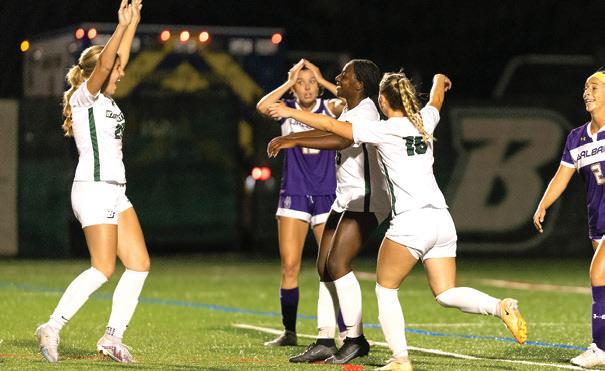
FALL 2023
The most accomplished male distance runner in school history, Erik van Ingen finished his Binghamton career as a four-time first-team AllAmerican and nine-time America East champion. He ran a sub–four-minute mile three times, was a conference cross country champion and later competed at the U.S. Olympic Trials. After transferring back home to Binghamton in 2008, van Ingen won the first of his nine conference titles with a victory in the indoor track 1,500 meters. One year later, he captured the America East individual cross country title and led the Bearcats a landslide team championship — the program’s first. Van Ingen became the first Binghamton athlete to run a sub–four-minute mile when he won the Penn State National Open in 3:59.58. In 2010–11, van Ingen advanced to the NCAA Cross Country Championship for the second straight year. In 2011–12, van Ingen tacked on two more first-team All-America honors and also ran a school-record 3:56.37 at the prestigious Wanamaker Mile — the 14th-fastest time in the world that year. He was honored with the John Bilos Award in 2012 for career achievement.

Women’s soccer goes unbeaten in conference play enroute to its second straight America East regular-season title.

APRIL 14, 2024
In its first season in the Northeast Conference (NEC), men’s tennis wins the first of two straight conference championships.

Emily Mackay is the most accomplished Binghamton University female student-athlete during its 25-year NCAA Division I era. She graduated as a five-time United States Track & Field and Cross Country Coaches’ Association All-American and won seven America East championships between cross country and track and field. She placed a program-best 14th overall at the 2020 NCAA Cross Country Championships and was sixth overall in the 1,500 at the 2022 NCAA Outdoor Track & Field Championships. In August 2024, Mackay became the first Binghamton women’s track alumna
to qualify for the Olympics when she advanced to the 1,500-meter semifinals at the Paris Games. Earlier in the year, Mackay was the bronze medalist in the 1,500 at the World Indoor Championships. Since signing professionally with New Balance Boston in June 2022, Mackay’s career has continued to blossom. In 2023, she become just the 13th American female to break the four-minute mark in the 1,500. Her current lifetime best time of 3:55.90 ranks third all-time in U.S. Women’s Track & Field history. Mackay returned to campus in February as the keynote speaker for the 20th Annual Celebrating Women’s Athletics Luncheon (CWAL), where she shared her goal of returning to the Olympics in Los Angeles in 2028.

MAY 5, 2024
Women’s lacrosse wins its firstever America East title — 12–11 over UAlbany in the conference finals — and advances to the NCAA Tournament for the first time. The Bearcats also win a share of the America East regular-season title for the first time in program history.

AUG. 8, 2024
Emily Mackay competes in the semifinals of the women’s 1,500 meters at the Paris Olympics.
After transferring from Seton Hall to rejoin Coach Allie Yaeger, Tsvetelina Ilieva forged the most successful volleyball career in program history from 2022–24. She graduated as a three-time America East Player of the Year and threetime All-American — both firsts for a Binghamton teamsport athlete. She also was named the University’s Athlete of the Year three consecutive years, the first time that has happened in 27 years. Academically, Ilieva was equally elite, having garnered national Academic All-America distinction by the College Sports Communicators (CSC). Only seven other Binghamton athletes have earned that distinction during the program’s 25 years at NCAA Division I. Thanks to a 3.99 cumulative GPA in business administration, she graduated with the highest GPA of any Bearcat student-athlete and was named an America East Presidential Scholar-Athlete.
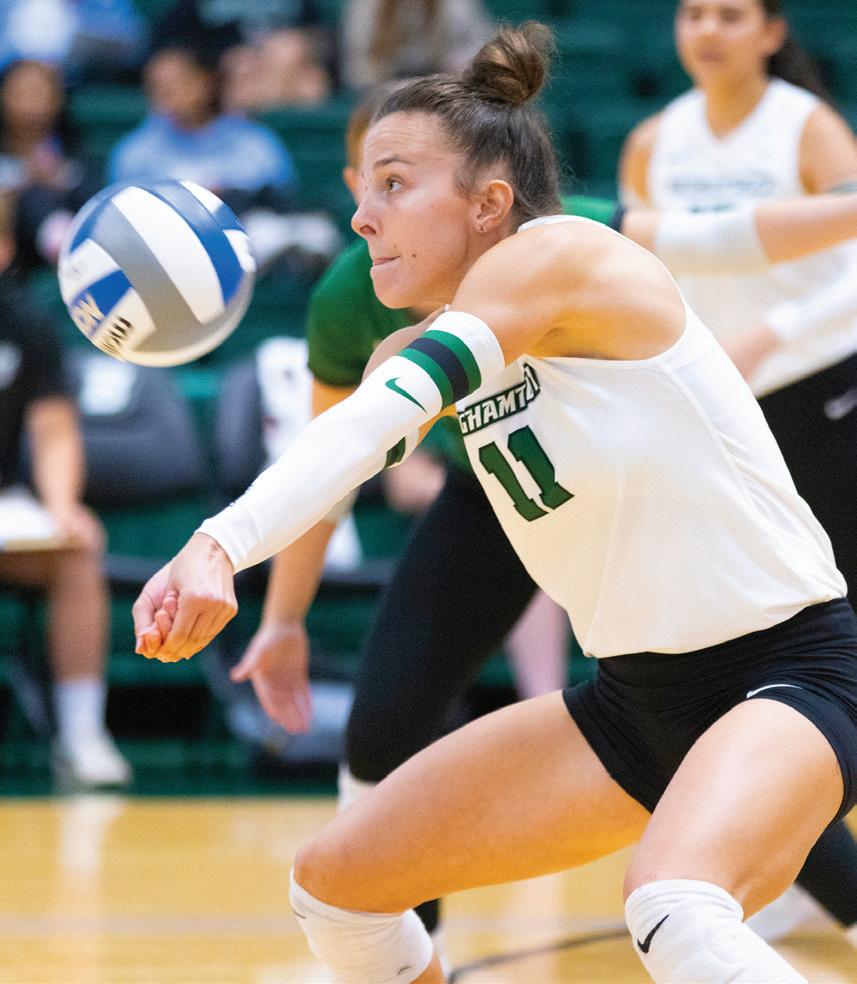

Tim Sinicki, the longest-tenured coach at Binghamton, added to his legacy last spring by steering his team to its second America East title in the last four years and 12th combined conference regular-season and tournament title. All those titles have come in the last 18 years, meaning his teams are now winning titles in two of every three years. Coaching in his 34th season this year, Sinicki owns the longest current coaching run of any NCAA Division I baseball coach at the same school.

2024–25
Tsvetelina Ilieva becomes a three-time volleyball All-American, three-time America East Player of the Year and three-time Binghamton University Athlete of the Year. She also earns America East Scholar-Athlete honors with a Binghamton student-athletebest 3.99 GPA.
He has been named America East Coach of the Year six times. Under his tutelage, 14 players have been selected in the MLB Draft. Sinicki began at Binghamton in 1993 and steered the Bearcats through their divisional move. He also provided critical stewardship of the historic $60 million donation for the current baseball stadium complex. He will enter the 2026 season with 729 career wins. Already a member of the Greater Binghamton Sports Hall of Fame, Sinicki was selected to the Binghamton Baseball Shrine in August in a ceremony at Mirabito Stadium, home of the Double-A Rumble Ponies.

FEB. 23, 2025
Men’s swimming wins its second straight America East championship and third title in five years.
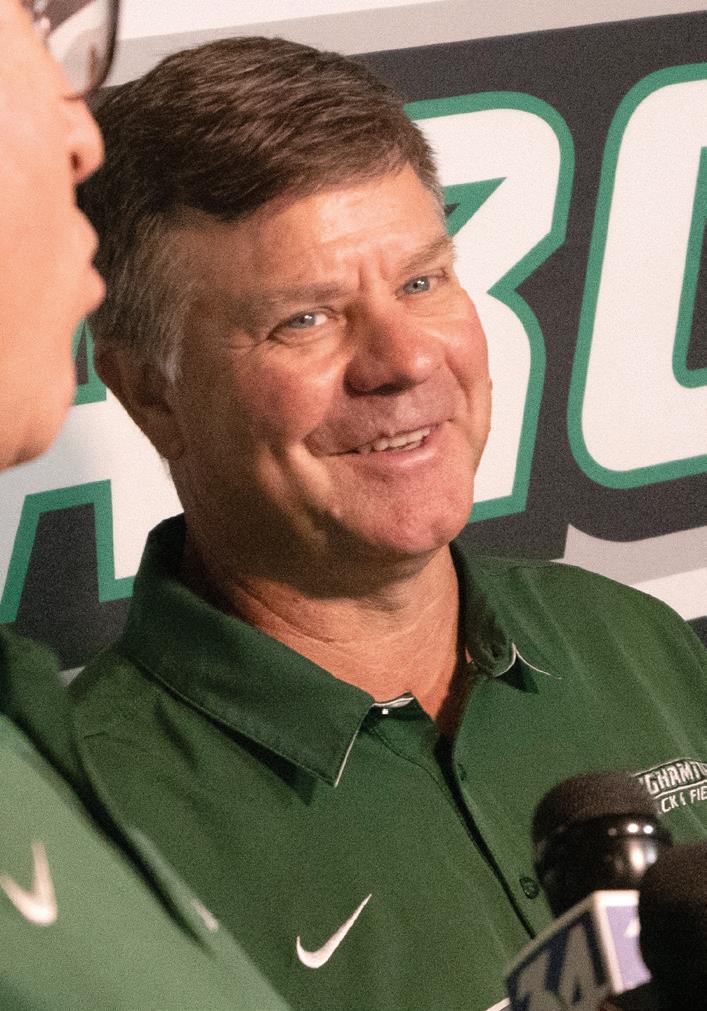
In her 26th season overseeing men’s and women’s cross country and the track distance runners, Annette Acuff has been put in the spotlight with her coaching and guidance of 2024 Olympian Emily Mackay. Acuff has built a successful Division I distance program from the ground up and has earned significant recognition at the conference, regional and national levels. She has coached five track and field All-Americans and one cross country AllAmerican at Binghamton. She also has coached four America East individual cross country champions

Mike Thompson owns the rare distinction of having coached NCAA champions at all three divisional levels. On top of that, he is a former two-time NCAA pole vault champion. Now in his 30th year as head track and field coach, Thompson has churned out All-Americans and upper-echelon teams at a steady pace. A seven-time America East Coach of the Year, Thompson has produced the school’s lone NCAA Division I champion (Rory Quiller), 67 All-Americans (20 at Division I) and he has had 16 different teams place among the top two in the America East. Before Binghamton moved up to Division I, Thompson coached six NCAA Division III champions and one winner at the 1999 NCAA Division II meet. Binghamton also had five Division II All-Americans and 42 Division III All-Americans. Thompson-led teams earned six NCAA top-10 finishes, highlighted by the 1998 women’s team that finished a department-best third in the nation.
A two-time New York State and NCAA Regional Coach of the Year, he also was named NCAA National Coach of the Year for men’s track and field in 1996.
and steered the track and field teams to 40 individual conference titles and 14 relay championships. Her teams have won three conference titles and she has been named America East Coach of the Year three times. Acuff also has been chosen as the USTFCCCA Northeast Region Men’s Assistant Track Coach of the Year three times and has won the women’s award twice. Last spring, she was honored at the Penn Relays for her career achievements.
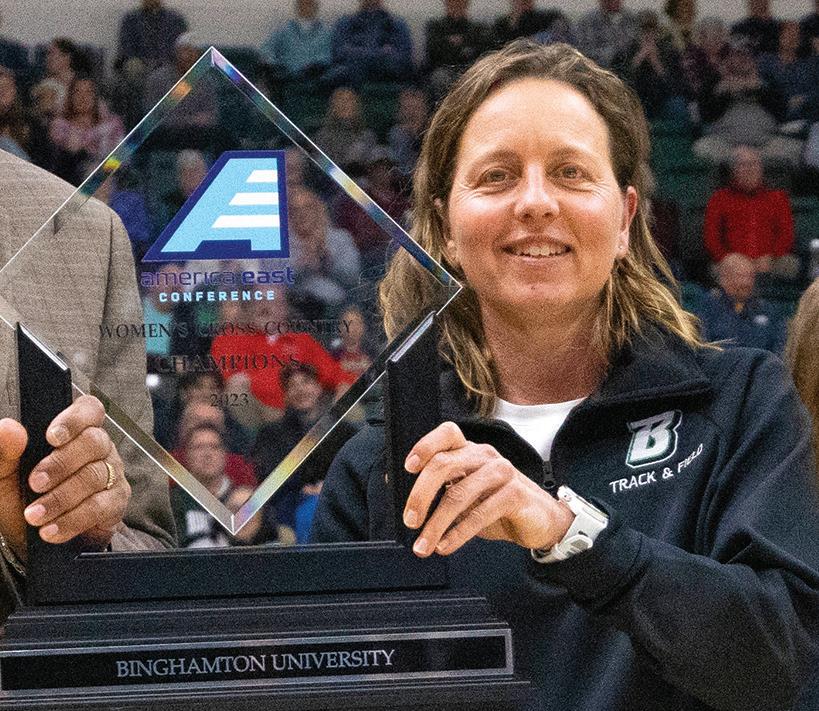
FEB. 23 AND MARCH 15, 2025
Men’s lacrosse attackman Liam Ferris earns a spot at No. 4 on ESPN’s Top Plays – the first Bearcat athlete to make two appearances on SportsCenter in the same season.

MAY 2025
Softball sweeps the America East regular season and tournament titles, advances to the NCAA Regionals and earns a final ranking of No. 17 in the D1Softball.com Mid-Major Poll.
Now in his 25th season, Paul Marco has been a mainstay on the soccer sidelines since 2002. Marco has led Binghamton to two America East titles, two America East regular-season titles and seven appearances in the conference title game. From 2003–08, Binghamton advanced to a conference-record six straight championship games. Since 2003, the Bearcats have also made 10 appearances in the conference semifinals.
In 2003, Marco led his team to an historic season, capped with the University’s first America East championship in any sport. Binghamton then stunned No. 15 Fairleigh Dickinson, 1–0, in the first round of the NCAA Tournament before extending No. 7 St. Louis to overtime in a second-round loss. Marco was named the New York State Region Coach of the Year. Now competing in an America East men’s soccer conference that is one of the toughest in the country, Marco’s 2024 team tied eventual NCAA champion Vermont and beat perennial NCAA tournament team New Hampshire.


JUNE 11, 2025
Marcus Johnson becomes the school’s first Division I All-American hurdler. Earlier in the spring, he is named the Most Outstanding Track Performer at the America East Championship.

JULY 14, 2025
Catcher Zach Rogacki is selected in the ninth round of the Major League Baseball Draft by the Colorado Rockies. He is the highest-drafted Binghamton position player in 35 years.
For the first time in program history, the Bearcats swept the America East regularseason and tournament titles. Binghamton finished the season 36–14, marking its most wins in 30 years. The Bearcats concluded the season by earning a No. 3 seed at the NCAA Oregon Regional and were ranked No. 17 in the final D1Softball.com Mid-Major Poll. Binghamton also became the first America East team to sweep all four major conference awards outright. Sophomore catcher Elisa Allen — who homered a school-record 23 times — was the Player of the Year. Junior pitcher Brianna Roberts — who won a program-record 21 games — was the Pitcher of the Year. Freshman catcher Rachel Carey was the top rookie and Jess Bump repeated as the Coach of the Year.
The men’s tennis team earned its second consecutive NEC Championship title, but did it the hard way this time as the No. 4 seed at the conference tournament. Binghamton defeated St. Francis, FDU and LIU, becoming the lowest seed to ever win the NEC title. William Morais Binnie was named Most Valuable Player, while Andre Ajed and Zubin Omar were selected to the All-Tournament Team. Binghamton then made its 11th NCAA appearance in program history. Head Coach Nick Zieziula earned his first NEC Coach of the Year award. The team also flexed its muscle off the courts: Junior Andrew Fang was named an Arthur Ashe Jr. Sports-Scholar Award winner and Binnie was selected as the NEC’s men’s tennis scholar-athlete.
The Bearcats earned the program's second America East title and NCAA Regional berth in the last four years. Binghamton went 15–7 down the stretch before dethroning regular-season champion and heavy favorite Bryant in a winner-take-all tournament finale. Senior third baseman Devan Bade was America East Championship MOP after collecting 12 hits and 12 RBI in the five tournament games. Freshman center fielder Matt Bolton set the school record for hits (78) and became the only freshman in conference history to lead the league in both hits and runs (61). In July, first-team all-conference outfielder/catcher Zach Rogacki was selected by the Colorado Rockies in the ninth round of the Major League Baseball Draft, becoming the program’s 22nd professional player.
Graduate student Marcus Johnson earned honorable mention All-America honors, highlighting the outdoor season. He placed 22nd overall in the 400 hurdles at the NCAA Championships. Johnson punched his ticket to the national meet with a seventhplace finish at the NCAA East Region Meet. Earlier in the season, Johnson was the Most Outstanding Men’s Track Athlete at the America East Championships after winning the 400 hurdles and anchoring the first-place 4x400 relay team. Graduate student Josh Stone capped his career with his second straight 5,000 title at the conference outdoor meet, while sophomore Brennan Delany was named the Most Outstanding Rookie at the conference meet after winning the decathlon. Senior Jennifer Mui highlighted the women’s season when she won the 3,000 steeplechase for the second straight year.




Women’s tennis began a new era under first-year Head Coach Paul Caceres in 2024–25. The Bearcats finished the year with seven wins, its highest win total in nine seasons. Clara Arbeloa Lopez was named to the Northeast Conference’s All-Rookie Team after Binghamton took home five weekly honors during the regular season. The Bearcats recorded four Division I victories, including a conference win over Le Moyne. Binghamton appeared in its second consecutive NEC Championship as the No. 7 seed, but fell to No. 2 St. Francis in the first round. Loren Cuomo led the Bearcats with 19 combined singles and doubles victories, while Kayla Castellano registered the most individual wins with 10.
The Bearcats had several outstanding individual performances before the team finished sixth at the season-ending NEC Championship in Williamsburg, Va. At the Howard/ USF Intercollegiate in September, Sean Shen came within a stroke of the school record when he shot a 5-under-par 65 in the final round. In early October, the Bearcats were runners-up for the second straight year at their home event, the Matthews Auto Collegiate Golf Invitational. To close out the fall, Brandon Conner won the Lehigh Invitational, becoming the first Bearcat to receive medalist honors since 2019. During the spring, Conner posted a pair of top 10 finishes and both he and Harrison Blech closed the year with top-20 performances at the NEC Championship.
After starting the season 0–4, the Bearcats bounced back with a four-game win streak and earned a postseason berth with a 12–7 victory over Vermont on Senior Day. In that regular-season finale, goalie Connor Winters made a school-record 22 saves and became Binghamton’s all-time leader in career saves, passing Head Coach Kevin McKeown’s total of 509. The Bearcats then pushed No. 1 seed Bryant to overtime in the America East semifinals before falling, 10–9. Liam Ferris, who made ESPN SportsCenter’s Top 10 Plays on two separate occasions during the season, received first-team all-conference honors after posting 36 goals and 12 assists. Joining Ferris on the first team was fellow
captain Lorenzo Ramo and Andrew Girolamo. Winters earned second-team honors, while freshman faceoff specialist Flynn Wilson made the All-Rookie Team.
The women’s lacrosse team produced several strong individual performances, but came up short in its bid to repeat as conference champions. Olivia Muscolino became the Bearcats all-time scoring leader with 209 points and 149 goals after a 50-point spring campaign. Emma Blloshmi and Angelina Suau earned spots on the all-conference first team, while Norah Kelly was selected to the AllRookie Team. Blloshmi set new Binghamton singleseason records with 59 goals and 30 free position goals. The junior attacker finished the regular-season atop the NCAA rankings with 2.0 free position goals per game. Blloshmi also led the conference with 4.3 points and 3.9 goals per game. Suau became the first Bearcat to earn three first-team designations after
she rose to first in program history with 87 career caused turnovers.
Ryan LeBlanc was named head wrestling coach in August. LeBlanc, who hails from Morrisville, N.Y., joined Binghamton after serving as the head wrestling coach at The Citadel since 2020. LeBlanc helped the program reach new heights by leading it to 41 dual victories, including a school-record 14 in 2023–24. The Citadel won 22 matches against Southern Conference opponents during that span, with the Bulldogs winning six league duals in each of their last two seasons. In the classroom, the Bulldogs had 15 NWCA Scholar All-Americans under LeBlanc’s watch. LeBlanc replaced Kyle Borshoff, who stepped down in July after serving as the Bearcats' head coach for eight years. He coached 25 NCAA qualifiers and recorded the third-most dual wins (56) of any coach in program history.

The $5.6 million overhaul of the track-andfield facility near the East Gym launched in August with a groundbreaking ceremony.
A significant investment from Visions Federal Credit Union is bringing the project to life — and the University will name the space the Visions Federal Credit Union Track & Field Facility.
The improvements to the 30-year-old facility include replacing the existing track to meet NCAA regulations, renovating the long- and triplejump event area and the pole vault area, adding
lighting and safety improvements, installing a new multisport synthetic turf field at the track’s interior, and updating the stands and scoreboard.
Binghamton athletics will embark on another major renovation in May 2026 when the $10 million Events Center upgrade begins. The project, scheduled for completion in late fall 2026, includes the replacement of the entire event-level surface, six track lanes, basketball court and bleachers.
by John Hartrick
Perhaps no one has experienced more and influenced more at Binghamton University than Gary Truce. The professor emeritus and Hall of Fame coach served the University for 53 years between 1968 and 2021. Now in retirement, he has added another title: legacy donor.
Truce and men’s tennis alumnus Michael Lane ’89 are spearheading an Athletics Division initiative: the creation of two philanthropic giving societies: the 1946 Legacy Society and the Bearcat Society.

For Truce, the role of helping students excel now extends to a seventh decade. He has assisted the cross country and track and field programs, as well as the Anderson Center for the Performing Arts, with scholarships and support.
“When I arrived on campus in 1968, I thought I would only be here for a few years,” Truce says. “Now, I think Binghamton is the best place I could have ever been for my overall career. The University has become special to me because I have seen such excellent growth in all aspects. Athletics has become a highly reputable program made up of excellent students academically and high-caliber young people. But the University also has had elite teachers, students in research, the arts, engineering, nursing, pharmacy, and all other departments on campus.”
Truce initiated the women’s track and field and cross country programs in the late 1970s, beginning a year-round cycle of coaching six teams and more than 100 athletes annually. His 1983 women’s
cross country team placed fifth at the NCAA Championship — the second-best national finish of any women’s team in school history. In all, Truce coached 14 All-Americans and seven Binghamton University Hall of Fame members. He also earned distinction as a lecturer, motivator and consultant on psychophysiological functions and a demonstrator in the art of hypnotism.
Truce hopes this giving pendulum swings high for future generations.
“I hope my gifts will inspire others to do the same,” Truce says. “I think gifting is a way of showing our gratitude to a highly recognized university — one that provided us all with so many memorable experiences.”
Tennis gave Lane roots and respect for the “grind”
Lane came from a single-parent home in Corning. As a freshman studentathlete at Binghamton, tennis was the one constant in a new environment — and one he could rely upon.
Lane was a four-year standout on tennis teams that captured back-to-back State University of New York Athletic Conference (SUNYAC) titles and won at a 78% clip in the late 1980s.
on to achieve success in the financial services industry. He has spent 30 years developing and leading the distribution of investment and insurance solutions.
Lane is now the head of Blackrock’s U.S. Wealth Advisory iShares.
Lane wife, Lisa, earned two degrees in political science from Binghamton — a bachelor’s degree in 1989 and a master’s degree in 1992. The family affinity for the University is strong.
“I am who I am today because of many influences, but few have been as impactful as my four years on campus,” he says. “My association with Binghamton athletics has felt more like family. Why wouldn’t I want to give back and be an active leader after all the experiences the University has given me?”
Lane has also served on the Binghamton University Foundation Board of Directors, has been a guest lecturer in the School of Management, and a networking panelist on campus. He was the lead donor for a tennis scholarship initiative, several facility upgrades, and, most recently, the purchase and renovation of the Lane-Starke Tennis Center (formerly Binghamton Tennis Center) on Binghamton’s Southside.

“I have a sense of pride having played tennis alongside great athletes and people at Binghamton,” he says.
After earning his bachelor’s degree in political science in 1989, Lane went
“My hope is that our alumni will be inspired to contribute,” Lane says. “You receive far more than you give, and I am living proof of that. Our university needs strong community support, and we should all look for ways we can contribute to building facilities, capabilities, and a reputation that everyone on and off campus can be proud of.”
Binghamton University’s Division of Athletics is proud to introduce two new philanthropic giving societies: the 1946 Legacy Society and the Bearcat Society. These societies honor the past, celebrate the present, and invest in the future of student-athletes.
Annual giving level: $10,000-plus
The 1946 Legacy Society honors a pivotal year in Binghamton University history. In 1946, Triple Cities College (now Binghamton University) fielded its first intercollegiate athletic teams, marking the beginning of a rich athletic tradition. Benefactors of the 1946 Legacy Society are the most generous supporters, whose contributions have a significant impact on Binghamton’s ability to compete at the highest levels of NCAA Division I athletics.
Annual giving level: $1,000-$9,999
Named after beloved mascot Baxter the Bearcat, the Bearcat Society recognizes donors who demonstrate a strong commitment to Binghamton athletics. Benefactors of this society play a vital role in enhancing the experiences of student-athletes, providing resources that support their academic and athletic endeavors.
1946 Legacy Society Members
Anonymous
William Baldwin ’85 and Chynna Phillips
Robert I Bodian ’77
Loretta Burgdorff and The Luciano Family
Taryn Clark and Colby Clark
Lisa Bouba Colacioppo ’96 and Mark A. Colacioppo ’94
Estate of William H. Cornell
Dr. Jo C. DeSantis ’84 and Salvatore J. DeSantis ’82
Cathleen M. Ellsworth ’86
Wendi Gallagher ’92, ’94 and Terence Gallagher
Joseph W. Haleski ’88 and Katherine C. Haleski ’88
Dr. Michael T. Harter ’64
Eric Hausler ’92 and Sari Hausler
Ruthanne Koffman ’82, ’84, Burton I. Koffman* and Family
Steven B. Kreinik ’97
Michael F. Lane ’89 and Lisa Marie Lane ’89, MA ’92
Dr. Bai O. Lee and Dr. Jung Yum
M&T Bank
Marianne Matties and Richard N. Matties
Tyrone E. Muse, LHD ’25 and Crystal Muse
Dr. Patricia A. Saunders ’65, LHD ’19
Dr. Gary Truce
Visions Federal Credit Union
Maureen Ziebarth and David Ziebarth
Bearcat Society Members
Nicole M. Abbott and Matthew J. Abbott
Jonathan M. Acquafredda ’95
Ellen Agresti and Joseph Agresti
Stephanie Allen
Arctic Bear
BRG Realty, LLC
Temitope O. Bajulaiye ’16
Andrew Blank ’92
Luminita Blloshmi and Kastriot Blloshmi
Susan Brierley
Susan Bump ’75
When joining the 1946 Legacy or Bearcat Society, it is more than a gift; it’s a partnership in a mission to provide exceptional opportunities for student-athletes. Your support helps fund what is most important to you, whether it be scholarships, team support accounts, state-of-the-art facilities, or comprehensive programs that foster success on the fields of competition and in the classroom.
Benefits:
• Exclusive updates and communications from Binghamton Athletics
• Recognition on the athletics official website and in select publications
• Invitations to special events and behind-the-scenes experiences
• Opportunities to connect with coaches, student-athletes and fellow supporters
By joining the 1946 Legacy or Bearcat Society, you become an integral part of our journey toward excellence. Your investment ensures that Binghamton athletics continues to thrive, honoring our history while building a promising future for our student-athletes.
To learn more or to become a member, contact the Binghamton University Athletics Development office at 607-777-3627. Together, we can elevate Binghamton University Athletics to new heights.
Dylan A. Caruana ’16
Michael W. Chisdak
Cleve E. Cleveland ’75
Walter Collins
Jennifer Congdon and Kevin Congdon
Laura Conner and Brad Connor
Ronnie Constable
George W. Curth Jr. ’90
Christopher D. Darling ’05
Richard A. Denmon ’79 and Paula A. Denmon
David L. Dini ’85
Diane L. Emmi ’76 and Francis Emmi, PhD ’83
Noreen Feldmann
Debra Ellen Friedman ’77 and Martin D. Friedman ’75
Amy Garofalo and Anthony Garofalo
Kimberly Gaube ’07, ’14 and Christopher P. Gaube ’09, MBA ’11
Elyse Gibb ’09, MAT ’10, and Robert P. Gibb ’04
Dr. Phillip J. Goldstein ’00
J. Keith Gorham ’73, MA ’75
Peter S. Groves ’84
Robert Herber
Hinman, Howard & Kattell, LLP
Andrew Hutchings ’05 and Sarah Hutchings
Brian Jester
Michelle Burrell Johnston and Daniel Johnston
Stanley R. Jones
Dina Kalina and Dennis Kalina
Elizabeth B. Kerr and Dr. Douglas R. Kerr
Joseph D. King ’96
Andrea D. Kreinik and Neil F. Kreinik
David Lambert
Christopher J. Lauro ’89 and Sharon Lauro
Heather Lenseth ’07
Jared Levine
Eugene Marshall Jr. and Phyllis Marshall
Raul K. Martynek ’88
Dr. Meghan A. McGuinness ’98, MA ’00, and Jay Duseau ’98, MBA ’11
Claudia Miller and Kevin Miller
Sherri Montenegro ’96 and Melanie Montenegro ’97
Robert J. Moss ’75 and Michela F. Nonis
Patrick Murphy
Kim Myers
Ronald R. Reedy ’80
Adele Reester ’94
Dan Rootenberg ’94
Janet Scarano and Anthony J. Scarano
Kathleen M. Schauer ’08
Jay A. Schwartz ’85
Mrs. Patty Sharkey and Mr. TJ Sharkey
David Simek, MBA ’88 and Sally Simek
Scott D. Soussa ’98
Michael J. Starke
Theresa M. Steflik and Joseph J. Steflik Jr.
James G. Stehli ’88
Maria Tarsia and Eric Tarsia
David F. Tauber
Julie M. Thomas ’00
Patti Tillman ’04 and Nicholas W. Tillman ’06
Gary M. Tischler ’84
James J. Toya ’86
Roy S. Tumpowsky ’64
Geralyn Van Gorder ’81 and Dr. Thomas R. Van Gorder
Leslie Vesper and Keith Vesper
Vision Contracting Corp.
Anthony J. Vitulli ’78 and Ellisa H. Vitulli
Monisha C. Walters ’05, MA ’06, and Bryan Walters
Janice Waters
Joseph I. Weiss ’96 and Roxanne Turley
Gail Wichler ’81 and Ranan J. Wichler ’80
Women's Lacrosse Parent Association
Ze Zeon and Sarah Zeon
Donna Zion ’92 and Isaac Zion ’92
* deceased



The Binghamton University men’s and women’s basketball teams, featuring Wes Peterson and Bella Pucci, open their 2025–26 seasons on Nov. 3. The men play at Syracuse University, while the women host Geneseo. The women’s non-conference schedule includes visits to Michigan and Syracuse, and a home game against St. Bonaventure. The men will travel to Georgetown and Pittsburgh before America East action starts.
